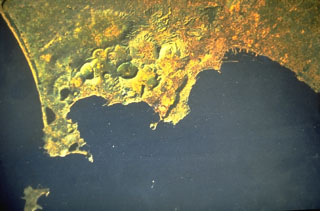Report on Campi Flegrei (Italy) — September 1984
Scientific Event Alert Network Bulletin, vol. 9, no. 9 (September 1984)
Managing Editor: Lindsay McClelland.
Campi Flegrei (Italy) More M > 3 events with wider distribution, but seismic energy release unchanged and uplift slows
Please cite this report as:
Global Volcanism Program, 1984. Report on Campi Flegrei (Italy) (McClelland, L., ed.). Scientific Event Alert Network Bulletin, 9:9. Smithsonian Institution. https://doi.org/10.5479/si.GVP.SEAN198409-211010
Campi Flegrei
Italy
40.827°N, 14.139°E; summit elev. 458 m
All times are local (unless otherwise noted)
"Activity at Campi Flegrei displayed some changes July-September. The monthly mean uplift velocity was in the range of 1.2 mm/day at Pozzuoli and
"Seismic energy release remained at the same level as in the past year. We observed a higher number of the most energetic events (M 3) than in past months (table 1). They are also no longer confined within the restricted area around Solfatara Crater, but instead occur all over the seismically active area.
Table 1. Magnitudes of the most energetic events in the Campi Flegrei area, July-September 1984.
| Date | Magnitude |
| 01 Jul 1984 | 3.7, 3.5 |
| 11 Jul 1984 | 3.8 |
| 22 Aug 1984 | 3.6 |
| 29 Aug 1984 | 3.9, 3.8 |
| 12 Sep 1984 | 3.3 |
| 13 Sep 1984 | 3.2 |
| 28 Sep 1984 | 3.5, 3.7 |
"The temperatures of fumaroles in Solfatara Crater remained stable. The radon content of the water wells reached a minimum in the last year, with a slight increase again at the end of September.
"The decrease in the uplift velocity during constant seismic energy release does not support the idea that uplift velocity is closely related to the occurrence of larger earthquakes. On the contrary, in this last period we have observed higher-energy events. They often occur as double events (1 July, 29 August and 28 September; table 1). The area that was previously affected by swarms of low-energy events (1 km W of Pozzuoli) is now also affected by high-energy events. We do not know if this pattern of activity indicates a higher risk of eruption."
Geological Summary. Campi Flegrei is a 13-km-wide caldera that encompasses part of Naples and extends to the south beneath the Gulf of Pozzuoli. Episodes of significant uplift and subsidence within the dominantly trachytic caldera have occurred since Roman times. The earliest known eruptive products are dated 47,000 years BP. The caldera formed following two large explosive eruptions, the massive Campanian ignimbrite about 36,000 BP, and the over 40 km3 Neapolitan Yellow Tuff (NYT) about 15,000 BP. Following eruption of the NYT a large number of eruptions originated from widely scattered subaerial and submarine vents. Most activity occurred during three intervals: 15,000-9,500, 8,600-8,200, and 4,800-3,800 BP. The latest eruption were in 1158 CE at Solfatara and activity in 1538 CE that formed the Monte Nuovo cinder cone.
Information Contacts: G. Luongo and R. Scandone, OV; F. Barberi, Univ. di Pisa.

